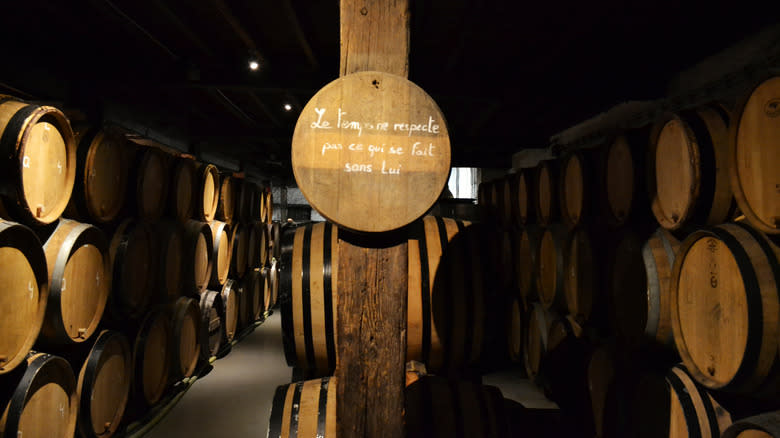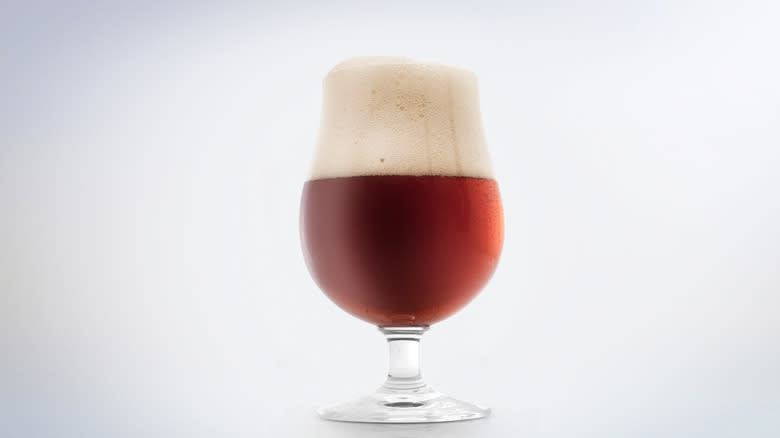What Exactly Is Lambic Beer And What Does It Taste Like?

You might think you know everything there is to know about Belgian beers, but are you familiar with the wonderful world of Lambic beer? It can come across as fruity like a cider, or even sour with hay flavors; different Lambics vary from sweet and sour like apples, to dry and barnyard-like. If you're new to the world of sour beer, Lambic may not be the place to start, but it's definitely a place you'll want to end up on your journey. This beer can be an acquired taste, but since there are so many different variations, the curious beer explorer should give each of them a whirl.
Fruit and beer are not strangers to each other; everything from limes to grapefruit are welcome companions to many types of beer. Lambic beer takes that combination a step further in that it's often brewed with fruit to create something that resembles a mead-like, cider-adjacent, Belgian beer. It's rustic in flavor and hearty in mouthfeel; this is all to say that while Lambics are wonderful, they're not subtle.
Read more: 10 Of The Healthiest Beers You Can Drink
Wild Fermentation

Lambic beer is an ancient style. It's Belgian in origin, and while there are producers in the US, those can't really be called a Lambic beer because of its unique fermentation process. The Belgian brewers allow wild yeast to ferment the grain, which is regionally specific (because apparently the yeast and bacteria floating around Brussels are quite different from the air bugs floating around Ohio -- which makes sense if you think about it). Beer that is wildly fermented outside of the region of Belgium where Lambic beer is produced must be called "Methode Traditionelle". Think about it like the difference between Champagne and Crémant: different regions, similar sparkle.
To begin a batch of Lambic, barley is rigorously mashed and then left in the open air to be inoculated by whatever comes in contact -- a much different process than your average commercial beer. This wild fermentation (and sometimes the addition of fruit) is what gives Lambic beer its distinctive qualities. Afterward, the beer is left to develop in oak barrels for up to three years, which gives it more of a cider-esque quality. The end product is slightly fizzy with little clarity; if it's a fruited Lambic, the flavor will take on many of the characteristics of the beer's fermented fruit buddy.
Fruits Of Labor

If you're drinking a fruit Lambic, you're most likely going to encounter the use of cherries or raspberries. In the case of stone-fruit fermentation like peach or apricot, the flesh of the fruit is eaten by the yeast for their sugars, while the stones are dissolved during fermentation, allowing them to lend nuttiness to the flavor profile of the finished Lambic. Some producers will add syrups to their fruited Lambics -- but these aren't the real deal. Puree or syrup used in lieu of whole fresh fruit results in an often overly sweet and cloying beer. So, if you do encounter one of these faux Lambics in the wild, don't let them shape your opinions too much.
Lambic beer has a strong, homely quality; it can come across like a tart, mouth-puckering French cider. While the prospect of drinking a glass of what can only be compared to mummy breath might not be immediately appealing, Lambic beer is something you truly shouldn't knock until you've tried it -- at least three or four times: After all, there's real beauty to be found in restraint.
Read the original article on Daily Meal.

